
Aspicilia is a genus of mostly crustose areolate lichens that grow on rock. Most members have black apothecia discs that are slightly immersed in the areolas, hence the common name.

Acarospora is a genus of lichenized fungi in the family Acarosporaceae. Most species in the genus are crustose lichens that grow on rocks in open and arid places all over the world. They may look like a cobblestone road or cracked up old paint, and are commonly called cobblestone lichens or cracked lichens,. They usually grow on rock, but some grow on soil (terricolous) or on other lichens. Some species in the genus are fungi that live as parasites on other lichens. Acarospora is a widely distributed genus, with about 128 species according to a 2008 estimate.

Protoparmelia is a genus of lichenized fungi in the family Parmeliaceae. The genus has a widespread distribution, and contains 11 species. Protoparmelia was circumscribed by French lichenologist Maurice Choisy in 1929.

Pilophorus acicularis, commonly known as the nail lichen or the devil's matchstick lichen, is a species of matchstick lichen in the family Cladoniaceae.

Lecanora muralis(Protoparmeliopsis muralis) is a waxy looking, pale yellowish green crustose lichen that usually grows in rosettes radiating from a center (placodioid) filled with disc-like yellowish-tan fruiting bodies (apothecia). It grows all over the world. It is extremely variable in its characteristics as a single taxon, and may represent a complex of species. The fruiting body parts have rims of tissue similar to that of the main nonfruiting body (thallus), which is called being lecanorine. It is paler and greener than L. mellea, and more yellow than L. sierrae. In California, it may be the most common member of the Lecanora genus found growing on rocks (saxicolous).

Oxneria fallax, also known as the hooded sunburst lichen, is a small yellow-orange to red-orange foliose lichen that grows on bark or rarely on rock or bone. It is found all over the world except very dry areas, with 10 species common in North America. The nonfruiting body (thallus) grows in rosettes to 3 cm in diameter. The rosettes sometimes coalesce with each other. The lobes may appear divided at the tips. It is sometimes tightly appressed to the substrate (adnate), and sometimes not. The fruiting bodies (apothecia) are lecanorine, meaning that they are disc-like with a ring or rim of tissue around the disc that is made of tissue similar to the thallus. The tips of the lobes form hood shaped soralia that produce powdery greenish yellow soredia. It prefers growing on elm or oak bark, but can also be found on rocks, bone, or other wood types. Lichen spot tests on the surface are K+ purple, C−, KC−, and P−.

Lobothallia is a genus of lichens in the family Megasporaceae. Species in the genus have foliose thalli that become crustose areolate in the center with age, and grow on calcareous to siliceous rocks. The crustose part of the body may keep its lower cortex, though not always. Dark brown to black apothecia may be sunken into the surface of the thallus, as indicated in the common name puffed sunken disk lichen. Members grow to 3–5 cm (1.2–2.0 in) or more radiating lobes (placoidioid). The photobiont is green alga from the genus Trebouxia. The genus is represented in Eurasia, Asia, North Africa, Central America, western North America, and Australia.
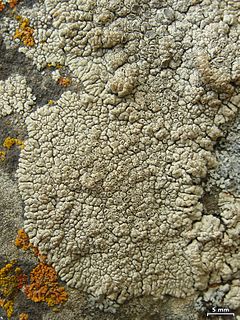
Lobothallia alphoplaca, the variable sunken disk lichen, is a creamy gray to brown, placoidioid areolate lichen that grows on rock in on rock and sometimes moss. It prefers growing on siliceous rocks. It is found in Europe, central Asia, and North America, where it grows in the southwestern deserts to central California. The center has numerous crowded and deformed apothecia with rims of thallus-like tissue (lecanorine). With dark reddish or grayish brown to black discs. Lichen spot tests on the thallus and apothecia are C−, and KC−, with tests on the cortex K+ red, P+ orange, or K−, P− and on the medulla K+ red, and P+ orange. It produces norstictic acid, constictic acid, or salazinic acid as secondary metabolites.

Acarospora fuscata is a glossy pale or yellowish-brown areolate lichen with angular areolas that grows up to 10 cm (4 in) wide on non-calcareous rock in low and high elevations. It grows in Europe and North America. It grows in southern California and on the eastern part of the Sierra Nevada range. It may grow with the areolas disconnected. The areolas may lift at the edges, but the areolas do not overlap like true squamules (sub-squamulose). More common in the Sierras is the similar species Acarospora thamnina, which is truly squamulose with overlapping scales.
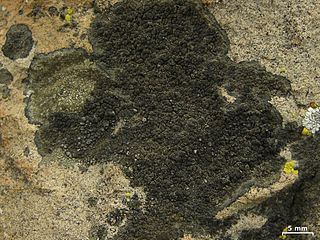
Buellia badia, the parasitic button lichen, is a dark chocolate-brown crustose areolate lichen of Europe, northern Africa, and North America that starts as a parasite growing on other lichens, such as Aspicilia phaea, gradually then becoming independent growing on rock (sometimes also on hardwood. Areoles may be contiguous or dispersed. Lecideine apothecia are 0.3 to 0.9 mm in diameter with black discs, that are initially flat, then become strongly convex as they age. Lichen spot tests are all negative. There are no known secondary metabolites as of. It is similar in appearance and other ways to the chocolate brown Dimelaena californica, which also starts off as a parasite on other lichens, and has spores of similar shape, size, and internal construction. D. californica has not been found on wood, is more preferential as to the lichens it starts growing on, and commonly has norstictic acid as a secondary metabolite. Some think they should be included in a new, third genus.
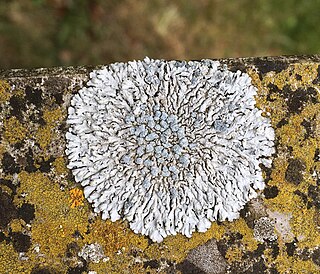
Physcia caesia, known colloquially as blue-gray rosette lichen and powder-back lichen, is a species of foliose lichenized fungus. First described by Georg Franz Hoffmann in 1784, it is common across much of Europe, North America and New Zealand, and more patchily distributed in South America, Asia, Australia and Antarctica. There are 2 subspecies: P. c. caesia and P. c. ventosa, as well as a number of distinct forms and varieties. Molecular studies suggest that the species as currently defined may be polyphyletic. It is typically pale gray shading to darker gray in the center, and grows in a small rosette, usually some 2–3 cm (0.79–1.18 in) across at maturity. It only rarely has apothecia, instead reproducing most often vegetatively via soredia, which are piled in round blue-gray mounds across the thallus's upper surface. It grows most often on rock—principally calcareous, but also basaltic and siliceous—and also occurs on bone, bark and soil. It is nitrophilic and is particularly common on substrates where birds perch.

Cladonia parasitica, commonly known as the fence-rail cladonia, fence-rail cup lichen or parasite club lichen, is a species of fruticose, cup lichen in the family Cladoniaceae. It was first described by Hoffmann in 1784 under the name Lichen parasiticus, until he reclassified it under the genus Cladonia in 1795.

Lecanora polytropa, commonly known as the granite-speck rim lichen, is a species of saxicolous lichen in the family Parmeliaceae. A small, inconspicuous species that grows in the cracks of rock surfaces, it has a cosmopolitan distribution and has been recorded on all continents, including Antarctica.

Xanthoparmelia lineola, commonly known as the tight rock-shield, is a foliose lichen species in the genus Xanthoparmelia. It is a common species with a temperate distribution. Found in North America and South Africa, it grows on rocks.
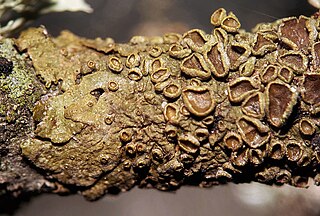
Melanohalea subolivacea, commonly known as the brown-eyed camouflage lichen, is a species of foliose lichen in the family Parmeliaceae.
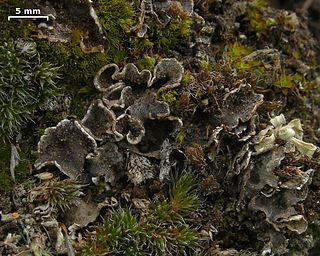
Peltigera lepidophora, commonly known as the scaly pelt, is a species of foliose lichen in the family Peltigeraceae. It was first described by Finnish lichenologist Edvard August Vainio in 1878 as a variety of Peltigera canina. German botanist Friedrich August Georg Bitter promoted it to species status in 1904.

Umbilicaria hyperborea, commonly known as blistered rock tripe, is a species of foliose lichen in the family Umbilicariaceae. It is widely distributed in arctic and alpine regions.
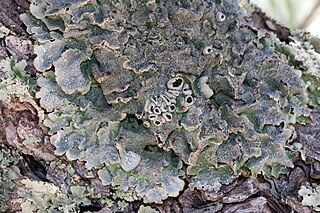
Punctelia hypoleucites, commonly known as the southwestern speckled shield lichen, is a species of foliose (leafy) lichen in the family Parmeliaceae. First formally described by Finnish botanist William Nylander as a species of Parmelia, it was transferred to the genus Punctelia in 1982. The lichen is found in Africa, North America, and South America, where it grows on the bark of both hardwood and coniferous trees. Its greenish-grey thallus is covered with tiny white pseudocyphellae – minute holes in the thallus surface that facilitate gas exchange. Some macroscopic features that help distinguish this species from other related members of the genus include the presence and the structure of the apothecia, the absence of asexual surface propagules, and the light brown color of the thallus undersurface. Chemically, the presence of lecanoric acid in the medulla and atranorin in the cortex help distinguish it from lookalikes.

Punctelia bolliana, the eastern speckled shield lichen, is a species of foliose lichen in the family Parmeliaceae. It is found in North America, with a distribution extending from the Canadian province of Ontario south to the central and northeastern United States and Mexico. It grows on the bark of both deciduous trees and coniferous trees. The combination of characteristics that distinguishes this species from others in genus Punctelia are the absence of the vegetative propagules isidia and soralia, a pale brown lower thallus surface, and the presence of the secondary chemical protolichesterinic acid in the medulla.

Punctelia graminicola is a species of foliose (leafy) lichen in the family Parmeliaceae. It grows on rocks, and, less frequently, on bark in North America, South America, and East Africa. It has a blue-grey thallus measuring up to about 15 cm (6 in), covered with tiny pores called pseudocyphellae. Sometimes the lichen forms small lobes that project out from the surface. Fruiting bodies are uncommon in this species; if present, they resemble small cups with a brown internal disc measuring 3–10 mm (0.1–0.4 in) in diameter. A lookalike species, Punctelia hypoleucites, is not readily distinguishable from Punctelia graminicola by appearance or habitat alone; these species can only be reliably differentiated by examining the length of their conidia.




















